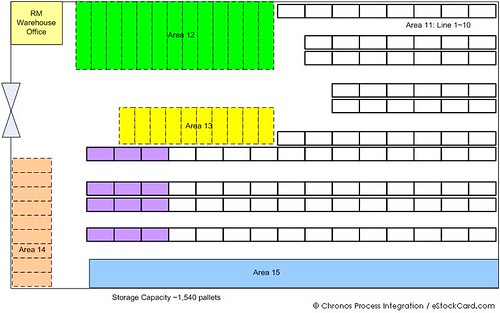Warehouse management systems (WMS) are best described as the advanced technology and operating processes that optimize all warehousing functions. These functions typically begin with receipts from suppliers and end with shipments to customers, and include all inventory movements and information flows in between. Warehouse management systems have typically been associated with larger, more complex distribution operations. Small, non-complex distribution facilities have historically not been viewed as candidates to significantly streamline operations and reduce costs. However, even smaller and midsize companies are increasingly recognizing the significance of warehouse management systems in today’s environment of integrated logistics, just-in-time delivery, and e-commerce fulfillment.
In practice, successful WMS solutions are generally designed to merge computer hardware, software, and peripheral equipment with improved operating practices for managing inventory, space, labor, and capital equipment in warehouses and distribution centers. Implementation of a WMS allows a company to increase its competitive advantage by reducing labor costs, improving customer service, increasing inventory accuracy, and improving flexibility and responsiveness. A WMS enables a company to manage inventory in real time, with information as current as the most recent order, shipment, or receipt and any movement in between.
WMS Benefits
* Faster inventory turns. A WMS can reduce lead times by limiting inventory movement and improving the accuracy of inventory records, thereby supporting a JIT environment. As a result, the need for safety stock is reduced, which increases inventory turnover and working capital utilization.
* More efficient use of available warehouse space. In addition to reducing safety-stock requirements, a WMS can often increase available warehouse space by more efficiently locating items in relation to receiving, assembly, packing, and shipping points. This increased efficiency can both improve productivity and lower inventory holding costs significantly.
* Reduction in inventory paperwork. Implementation of a real time WMS can significantly reduce the paperwork traditionally associated with warehouse operations, as well as ensure timely and accurate flow of inventory and information. Receiving reports, pick tickets, move tickets, packing lists, etc., which are typically maintained as hard copies, can all be maintained electronically.
* Improved cycle counting. Companies can use WMS to capture relevant data (e.g., frequency of movement, specific locations, etc.) to systematically schedule personnel for cycle counts. Such cycle counts not only can improve the accuracy of inventory records for planning purposes, but also can eliminate or reduce the need for complete, costly physical inventories.
* Reduced dependency on warehouse personnel. Implementing a comprehensive WMS facilitates standardization of inventory movements, picking methods, and inventory locations. This standardization helps to minimize reliance on informal practices, resulting in reduced training costs and lower error rates.
* Enhanced customer service. By streamlining processes from order to delivery, companies can more accurately determine product availability and realistic delivery dates. A WMS can automatically identify and release back-ordered inventory and also can reduce returns as a result of increased shipment accuracy.
* Improved labor productivity. A WMS helps optimize material flow, typically by incorporating several inventory picks into one or by “cross docking”. Cross docking is a process that routes incoming shipments to the location closest to the outbound shipping dock, thereby reducing warehouse handling.
Advantages for WMS Users
For Management: WMS can help management to access an instant picture of
* How much inventory exists in the warehouse
* How many orders are currently being shipped
* What are the stages of processing of pending orders
* Staff productivity details
* Goods shipped by the warehouse over any given period of time.
The warehouse management can determine how much inventory exists in the various stages of processing unlike in non-automated warehouse management.
Sales people can determine how much inventory is available and can relate better to the warehouse staff thus bettering their Customer Relationship levels. Customer Managers can reserve inventory for a customer thereby ensuring that it will not be shipped to anyone else. Inventory Managers can track transactions at a very fine detail to diagnose unexpected sudden changes in inventory. For example, if we had thousands of pieces of some SKU yesterday and today we don’t have any, then where did they go? Were they shipped to some other customer? Were they sent to some other warehouse of the company to be shipped from there? Or did they get lost or were picked away? WMS helps answering such problems. The reports generated during checking processes enable policy decision to be taken about the reliability of the suppliers. WMS is designed to be flexible i.e., the process flow of the DC/Warehouse can now be modified easily as business needs change.
For Warehouse Supervisors: Productivity reports for each operator can now be generated and used to implement productivity based remuneration schemes or to fire unproductive employees. For those warehouses that have to cope up with Union problems these reports can help the company tremendously. Efficient tracking of warehouses activities are possible with WMS as it provides a comprehensive set of web-enabled reports detailing all the activities happening in the warehouse and their effect on the inventory management. WMS also helps to detect bottlenecks in operations, which can increase the overall throughput of the warehouse.
For Warehouse Operators: WMS provides graphical user interfaces (GUIs) wherein most of the time the operator has to just scans the barcodes. Default navigation of cursor on the screen mimics the standard business rule. Thus WMS eases the operator’s task and makes the data input process fast, increasing the overall efficiency of the operator. Some programs like Locating and Pulling are especially designed to run on hand-held radio frequency terminals. These terminals make the task of pickers and locators easy, as these are easy to carry. Modern WMS programs have been coded with extra emphasis on scanner based data input to minimize the need for keyboard or mouse input.


